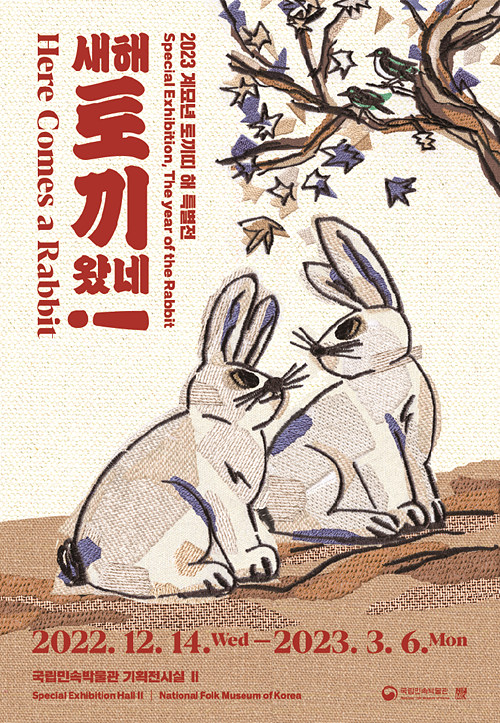Exhibitions
| Title | Here Comes a Rabbit | ||||||||||||||||||
|---|---|---|---|---|---|---|---|---|---|---|---|---|---|---|---|---|---|---|---|
| Period | December 14 2022 - March 6 2023 | ||||||||||||||||||
| Venue | Special Exhibition Hall Ⅱ (NFMK Seoul) | ||||||||||||||||||
|

2023 is the Year of the Rabbit.
One of the 12 animal guardians, the rabbit represents many things in Korean folklore. Physical features and behavior are major factors in determining an animal's symbolism, and those of the rabbit have also sprung many different symbolisms. The special exhibition Here Comes a Rabbit explores the rabbit as a folkloric symbol for wisdom, agility, the moon, and conjugal affection in light of its biology including anatomy and behavior. Prologue - The Year of the Rabbit: As what is called the rabbit guards the East The rabbit is the fourth of the 12 animals in the Korean Zodiac. In terms of direction, it represents the East where the sun rises. In terms of month and timeslot, it corresponds to the second month of the lunar calendar and the time window between 5 a.m. and 7 a.m. 卯 (myo), the Chinese character for “rabbit”, is a hieroglyphic resembling an open door, hence, the month of myo symbolizes the energy of spring when life burgeons from the ground and is considered important in folklore as it is associated with the beginning of the farming year. The timeslot of myo corresponds to dawn-the beginning of the day-which is why breakfast, morning sleep, and alcohol before meals are respectively called myoban, myosu, myoeum. As such, the rabbit signifies the “beginning” and by extension the “growth”, “prosperity”, and “proliferation” of all living organisms.
1. The Rabbit’s Colorful Biology: When all kinds of painters gathered to portray the rabbit The physical appearance and behavior of the rabbit birthed various meanings and symbolisms. Its big, long ears, round eyes, cleft mouth, short forelegs, long hind legs, and stubby tail begot both fables and taboos. Its sensitivity to small sounds, alertness to its surroundings, and agility in hopping through the woods have also inspired proverbs and idioms.
2. The Rabbit’s Colorful Transformation: From a Clever Trickster to Beloved Character Designs So, what do modern-day people make of the rabbit's symbolism, which lies somewhere in between agility and frivolity, and wisdom and trickery? Its unique physical features, such as long, big ears and stubby tail, are used as motifs in children's stories and product design. Narratives featuring rabbits as the protagonist, such as “The Rabbit and the Tiger” and “The Hare and the Tortoise”, are still told today in the forms of traditional folktales and classical novels. Images associating the rabbit with the moon are also widely explored. Today, rabbits are considered one of the cutest and most adorable animals. A recent survey shows that both children and adults deem rabbits friendly and likeable, which might be why they are such a popular motif for various children's products and daily appliances. Products sporting rabbit characters are still popular, and the term “rabbit” is even used as a nicknames for some of Korea's favorite idols. As such, the rabbit has settled in the Korean hearts and culture as a meaningful animal.
The Moon Rabbit: Upon first light, the rabbit fed on yang energy, entered the Moon Palace, and milled the longevity medicine underneath the laurel tree The rabbit is closely associated with the moon. Everything from Goguryeo-period tomb murals to Joseon-period poems, folk paintings, and oral literature suggest that Korean people of yore believed a rabbit to be living on the moon. Koreans of yore deemed rabbits as spirits of the moon or the moon itself. The story of the rabbit who ended up on the moon has its origins in the “Tale of Jeseokcheon(S'akrodevandra)” and the “Tale of Hanga (Chang'e)”. The fact that the Chinese character for rabbit, “兔” (to) is used in Korean words for “the moon” (towol, tobaek) and the “shadow of the moon” (toyeong) attests to this symbolism. Also found in the lyrics of the Korean children's song “Half Moon”, the story of the rabbit beneath the laurel tree on the moon is still widely explored in children's content.
Epilogue: Happy New Year! Ssangtodo, depicting a pair of affectionate rabbits, symbolizes conjugal love and a harmonious family, and Chueungtobakdo, in which a hawk is gazing at a rabbit, is a representative image used to celebrate the new year. Ahead of every new year, we send our greetings to those around us, wishing them the best. This year, it would be nice to convey our new year's wishes through folk images of rabbits.
Materials
|
|||||||||||||||||||
| Date | 2022-12-19 | ||||||||||||||||||
| 이전글 | Wonderful Times |
|---|---|
| 다음글 | 조명치 해양문화특별전 (Croaker, Pollock, and Anchovy) |











